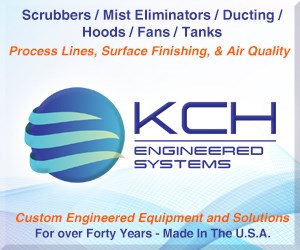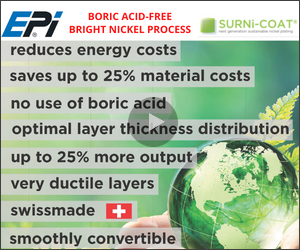Metal finishing companies may soon be forced to purchase insurance or bonds in case one day their facility contaminates the soil and water around it.
The U.S. Environmental Protection Agency is currently mulling what industries to invoke new clean-up rules as part of the Comprehensive Environmental Recovery and Liability Act.
One of those industries—metal finishing—was on the target list when EPA first developed the CERCLA guidelines several years ago, but survived when the EPA picked only hard rock mining as the industry to undergo the first standards, which requires facilities to establish and maintain some type of financial responsibility (insurance, bonds, trusts, etc.) in case of hazardous substances releases.
But in January 2010, the EPA announced that it would develop financial responsibility requirements for the chemical manufacturing, petroleum and coal manufacturing and the electrical power generation industries. They also announced they would start taking a closer look at other industries, specifically the metal finishing sector.
The EPA announcement said it “plans to conduct further in-depth studies before deciding whether to begin development of a proposed regulation” for those industries, including metal finishing.
CERCLA was enacted in 1980, but EPA had not set up financial responsibility guidelines until it was sued by the Sierra Club in 2008. The EPA then made financial responsibility a top item on its ‘National Enforcement Priority’ and set about to propose industry rules.
In Feb. 2009 the federal judge overseeing the Sierra Club lawsuit ordered EPA to comply with CERCLA, and the agency in July 2009 picked the hard rock mining industry to be the first to have rules imposed.
“Financial Responsibility” could mean insurance, a written guarantee, a surety-bond, a letter-of-credit, or even a self-insurance option, as the EPA has used similar tactics under others acts and laws it oversees.
One thing working in the finishing industry’s favor is the remarkable amount of waste reduction that has taken place. EPA data shows that from 1990 to 2007, the finishing industry—which includes electroplating, plating, polishing, anodizing and coloring – has reduced the amount of its “Toxic Release Inventory” from over 14 million tons to nearly 6 million, or a nearly 60% cut.
Related Content
-
Evolving coatings and finishes for automotive brake components.
-
Bryan Leiker, executive director, Metal Finishing Association of California, offers a recap of a January 27, 2023, public hearing conducted by the California Air Resources Board prior to an impending ruling on a proposed ban of hexavalent chromium use for finishing operations in the state.
-
As the finishing industry begins to move away from the use of hexavalent chromium to trivalent chromium, what factors should finishers consider as they make new investments? Mark Schario, chief technology officer for Columbia Chemical offers a helpful overview of this complicated topic.









.jpg;maxWidth=300;quality=90)


